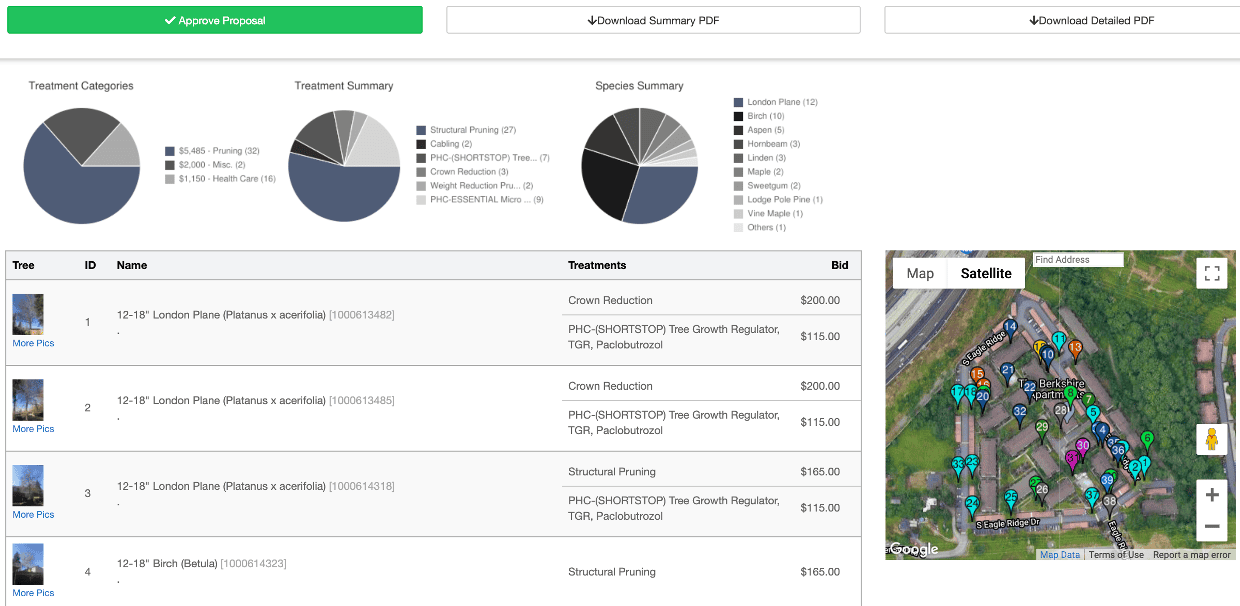Leaves are changing color and beginning to fall, tree growth is slowing—so is there anything that our trees need while entering this new season? The answer is yes. Fall tree care is essential to help trees transition smoothly into winter and to prepare them for vibrant growth in spring. Let’s take a look at what you can do to support your trees during this critical time.
Fall is the Perfect Time to:
1. Prevent Storm Damage
2. Feed Roots & Soils
3. Plant New Trees
4. Prepare & Budget for Next Year

1. Prevent Storm Damage
Winter storms are right around the corner. High winds and rainfall mean increased tree failure, property damage, and liabilities. Fallen limbs not only cause damage but also create safety hazards that can be avoided with timely maintenance.
Pruning in fall reduces the need for emergency tree work. Deciduous trees also go bare in fall, so weak limbs are easier to spot and can be removed more thoroughly.
Proper pruning to reduce storm damage will help to:
- Remove diseased, damaged, and dead limbs
- Remove crossing branches, water sprouts, and suckers
- Reduce excess branch end weight
- Avoid over-pruning, which results in tree stress and decline
If your trees need extra support, use cables and other tree support systems to reduce the risk of tree failures. Addressing these issues now helps trees during fall remain safe, even in harsh weather conditions.
Fall is also a good time to assess overall tree structure. Look for limbs that hang over your house, shed, or power lines. Eliminating these risks now can prevent emergencies during severe winter weather.
2. Feed Roots & Soils
Roots and soil are often the "root" of tree health problems. But root and soil care are one of the easiest and most economical things to do with your budget. Trees in fall season depend heavily on strong roots to get through the dormant winter months.
Trees undergo the most root growth in the fall to prepare for winter dormancy. Give the roots a boost right now when they need it most.
Soil Amendments
A Plus provides soil injection treatments that deliver "all the good stuff" directly to the tree's root system. Our special blend consists of:
- Naturally derived nutrients
- Minerals
- Biochar to boost soil health
- Yucca extract for water retention
Mulch
Another thing to do is mulch. Mulch is a tree's best friend. It provides a whole host of benefits such as:
- Organic nutrients
- Water retention
- Weed suppression
- Root protection
- Temperature moderation
Healthy soil encourages vibrant autumn trees and supports growth cycles into spring. Without it, trees in fall season may show stress that compounds over time. Remember to reapply mulch as needed and keep it a few inches away from the trunk.
3. Plant New Trees
Fall is perfect for planting new trees. Cooler weather and more rainfall mean two things everyone loves—better tree survival and less irrigation. Planting right now gives you the biggest bang for your buck.
Fall weather is also optimal for root growth, so planting in the fall helps your new trees get established. As always, mulch is a tree’s best friend, so protect the roots with a 2-4" thick layer.
Planting trees during fall allows them to focus energy on developing a solid root system instead of supporting new foliage. This makes them stronger and more resilient when spring arrives. Tree in autumn may not show new growth above ground, but they are busy below, setting strong foundations.
Choose species that are well-suited to your local climate and soil conditions. Also consider how much space your tree will need as it matures to avoid future issues with crowding or infrastructure interference.

4. Monitor Tree Health During Fall
Fall is more than just a transition—it’s a time when your attention can make a lasting impact. Regularly checking trees during fall helps spot early issues that may go unnoticed until spring.
- Watch for mushrooms or fungal growth near the base
- Look for peeling bark or small cracks in the trunk
- Observe whether leaves are changing color too early or dropping too soon
These signs often indicate stress. Addressing them in the fall can save time and costs later. Tree in autumn may seem quiet above the surface, but they’re still busy below. Stay proactive to keep your trees healthy and thriving.
5. Prepare & Budget for Next Year
Get your trees assessed to prepare for next year. Knowing what you have and what needs to be done helps you plan and budget. Planning in advance helps prevent costly surprises and ensures your landscape thrives.
Our Certified Arborists walk your property and prepare detailed, customized proposals using our ArborPlus app, all for free. We also provide multi-year tree care plans to suit your needs and help you budget wisely.
Take the time in the fall to inspect your trees and spot any problems before the growing season starts. This is especially helpful for older trees that may not bounce back as quickly from damage or disease.
Evaluate whether new plantings or treatments should be scheduled. Thinking ahead not only saves money but keeps your trees in the best shape year after year.
Don’t Forget to Evaluate Your Whole Landscape
While trees are a major focus of fall care, your entire yard may benefit from seasonal maintenance. Check for drainage issues that could affect root systems and consider aerating compacted soil areas. Pay attention to how ground cover interacts with your trees—make sure mulch isn't smothering the trunk and that gravel doesn't raise soil temperatures too much. Fall is the right time to take stock and make small adjustments that support a thriving outdoor space year-round.





